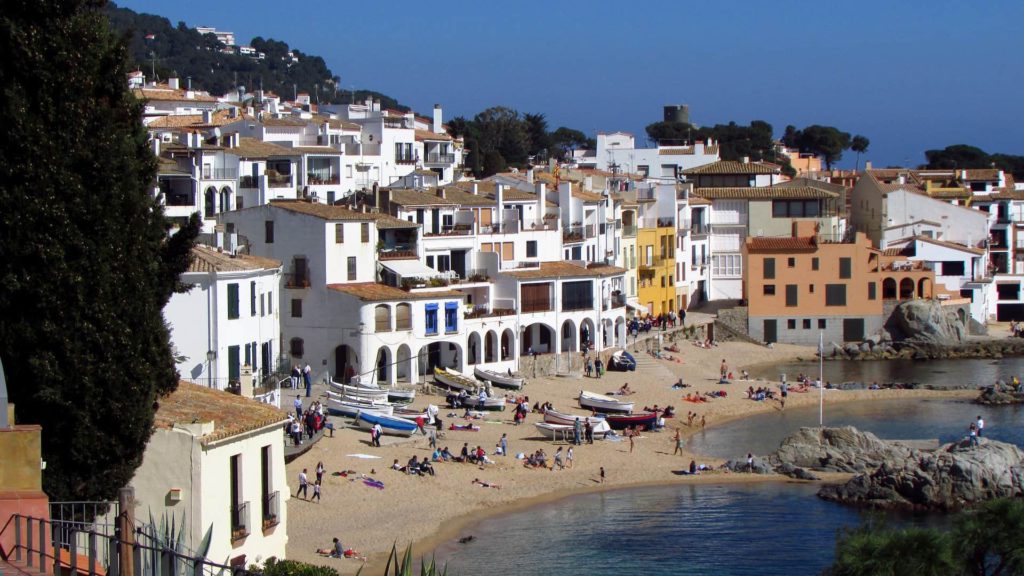The Costa Brava “Wild Coast” or “Rough Coast” is a coastal region of Catalonia in northeastern Spain, beginning in Blanes and touching the border with France.
The coast was named Costa Brava by Ferran Agulló in an article published in the Catalan newspaper La Veu de Catalunya in September 1908. And it is actually Brava, (wild) given the rugged and spectacular vegetation, trees that meet the sea in small coves, blue waters.
The central part of the Costa Brava belongs to the region of Baix Empordà, whose capital is La Bisbal d’Empordà, with the Montgrí Massif extending on its north, from L’Escala to the village of L’Estartit, part of the municipality of Torroella de Montgrí. The River Ter pours its water at this point, near a small archipelago known as Medes Islands. Further south, following a stretch of beach and marshlands, are the towns of Pals, Begur and Palafrugell. At this point the Gavarres Massif meets the sea, with a coast marked by rugged cliffs, small bays and beaches amid coastal villages such as Aiguafreda, Fornells, Tamariu, Calella de Palafrugell and Llafranc. The town of Palamós, further south, is a major commercial and fishing port.
It is a perfect holiday destination, and taking as the center of that region , Iberinbound, introduces you to Palafrugell. Iberinbound Travel, iberinbound@iberinbound.com is an incoming travel agency, specialized in Spain and Portugal Shorex, Groups and also Groups ad-hoc by request, Luxury and VIP destinations. At Iberinbound our personalized service is our trademark. We guarantee a fast, courteous and professional service with meticulous attention to detail which will ensure that your event in Spain is an outstanding success.
Calella de Palafrugell
This medieval town was once fortified but is no longer. Many narrow streets emanate from Plaça Nova -a large square with bars, restaurants and boutiques.
From the Gardens of Cap Roig to Llafranc we find eight coves and beaches each with a special charm, typical of the orography of the coast of the Costa Brava, more rocky and among pine trees. All joined by the Camí de Ronda, which awaits those hikers and lovers of good views. A few meters away, the beach of Sant Roc or the Canyers, unmistakable because it watches over it from the top Sant Roc with views of the entire coast of Calella, also for its old fishermen porticoes and for the Sant Roc fountain, listed as a Singular Good of Calella de Palafrugell. Following the letter to the writer Josep Pla, there are no better views of the entire coast of Calella and Llafranc as you will see from the Far de San Sebastià, built in 1857. “The lighthouse of Sant Sebastià, which is the most powerful in Catalonia”.
Elevated on the cliff of more than 170 meters above the sea, it seems that nothing is disturbing here and everything is calm, stroll around and follow the marked path that will take you to the viewpoint of the Divine Pastora.Calella de Palafrugell is symmetrical, perfect , exhaustingly pretty and hopelessly seductive.
Port Bo
It is the most beautiful town on the Costa Brava. An idyllic beach! Definitely a corner with charm! for snorkelers a mustvisit in full order.
Grau Wineries
On the road from Palafrugell to Torroella de Montgrí are the Grau wineries, a place where you can find a huge variety of wines, very varied liquors, different and rarely seen, at a good price. It is easy to find people who come from France on a daily basis, from restaurants in the area in search of their wine list, locals and visitors who pass through the area (alcohol enthusiasts, above all), we cannot avoid making a stop to look for a good wine or a hard-to-find liquor .
Cap Roig Gardens Festival
A summer festival located in the Botanical Garden in Calella de Palafrugell is something really tempting and if it is also celebrated during the summer months of July and August even more.
This is the Cap Roig Gardens Festival, located in a unique place, close to the sea and with room for different performing arts. Dance, classical music, pop, jazz, opera, etc. They are just some of the modalities that occur each year during the summer months.
Iberian Village
The Iberian Village located in the Mountain of San Sebastián de la Guarda and dates from the 15th century BC.
The site was discovered in the 60s and the pieces that were found are exhibited in the Cork Museum.
The ruins are still maintained, which are still being studied, and a path has been organized with explanatory panels of what is known about this ancient population.
Gastronomy
Adri is the town of sausages in the Girona region, so guess what to eat … and enter the Vall de Rocacorba in the Gironés region, surrounded by landscapes of volcanic origin.
In Palafrugell many restaurants with good cuisine from the province of Girona. We will find here fusion of the kitchen: natural, market, traditional and sophisticated, by the hand of their chefs, the flavors they achieve are incredible, satisfying the most demanding palates.
They stand out from a wide variety of dishes: suquet and ampurdanese rice, chicken with crayfish and veal with mushrooms. And lots, but lots… of fresh fish and seafood.


